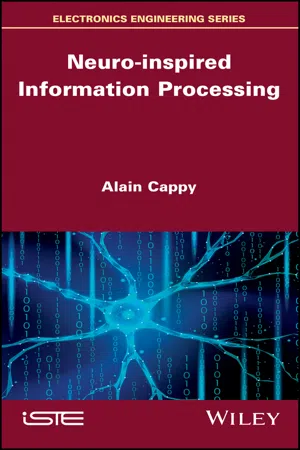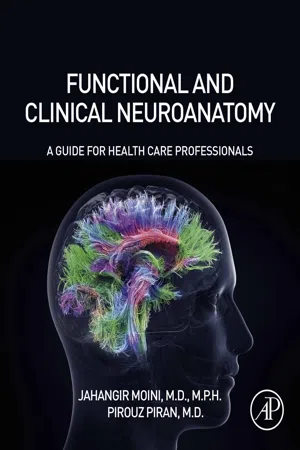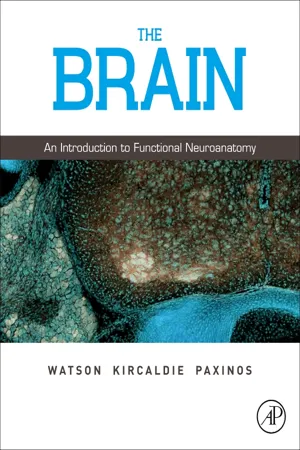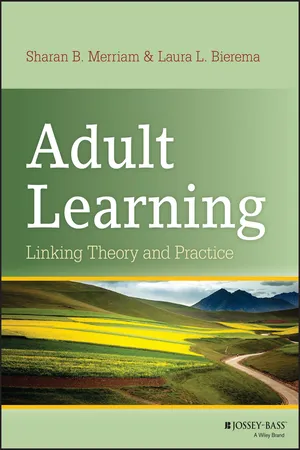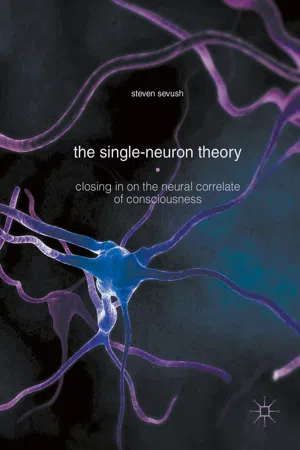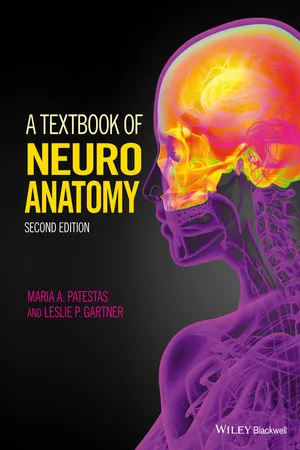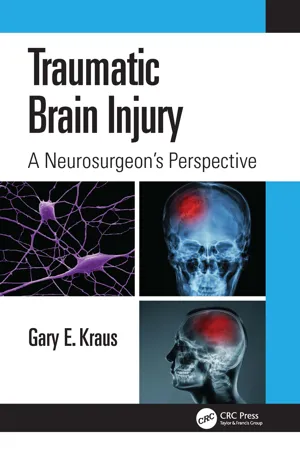Psychology
Functions of the Cerebral Cortex
The cerebral cortex is responsible for a wide range of functions, including sensory perception, motor control, language, memory, and higher cognitive processes such as reasoning and problem-solving. Different areas of the cerebral cortex are specialized for specific functions, and the integration of these functions allows for complex behaviors and cognitive abilities.
Written by Perlego with AI-assistance
Related key terms
Related key terms
1 of 4
Related key terms
1 of 3
9 Key excerpts on "Functions of the Cerebral Cortex"
- Randy W. Beck(Author)
- 2011(Publication Date)
- Churchill Livingstone(Publisher)
The cortex in humans is composed of several well-identified functional areas, interspersed in the cortical matter referred to as association cortex. Although we will speak of functional localisation of a variety of areas of cortex, in reality the functional systems of the neuraxis work in conjunction with each other to produce the best possible outcome for the circumstances at hand. For example, the thought processes attributed to the frontal cortex need to interact with the basal ganglion in order to flow and unfold in a meaningful way. The hippocampus and amygdala are essential functional areas for the fusion of emotions and behavioural response which are attributed to cortical functions. Movement, controlled by the motor cortex in the frontal lobe, is meaningless and random without the feedback supplied by the spinal cord and cerebellum. The cortex can be divided into the lobar areas, as outlined below.Quick facts 9.6Layers of cerebral cortex- • It is convenient for learning purposes to divide the cerebral cortex into layers that may be distinguished by cell types, cell functions, cell density, and cell arrangements.
- • These layers include six levels of cortex (layers I–VI) also named from superficial to deep:
- • Molecular layer (plexiform layer)
- • External granular layer
- • External pyramidal layer
- • Internal granular layer
- • Ganglionic layer (internal pyramidal layer)
- • Multiform layer (layer of polymorphic cells)
Quick facts 9.7Types of cells in the cortex- • Martinotti cells
- • Neurogliaform
- • Basket cells
- • Horizontal cells
- • Fusiform cells
- • Stellate cells
- • Pyramidal cells
The frontal lobes
The frontal lobe is concerned with sophisticated operations such as higher-order sensory processing, planning, implementation, language processing, abstract thought, and regulation of movement, cognition, emotion, and behaviour. The most anterior part of the frontal lobe is involved in complex cognitive processes such as reasoning and judgement. Collectively, these processes may be called biological intelligence . A component of biological intelligence is executive function- eBook - ePub
- Alain Cappy(Author)
- 2020(Publication Date)
- Wiley-ISTE(Publisher)
- – the cerebral cortex, or gray matter, constitutes the outer layer of the brain, a layer that contains a large proportion of neurons. It is subdivided into several lobes, defined according to their location: the frontal lobe (motor skills, memory and reasoning), the parietal lobe (touch), the temporal lobe (hearing and smell) and the occipital lobe (vision);
- – the thalamus, which mainly acts as a relay and integrator of afferent sensory and sensorial information and efferent motor information;
- – the hypothalamus, which is involved in regulating major functions such as hunger, thirst, sleep and body temperature;
- – the pituitary gland, which produces hormones;
- – the hippocampus (not visible on the cross section presented in Figure 2.1 ), which is involved in attention, spatial memory and navigation;
- – the cerebellum, which manages motor coordination and learning of routine movements;
- – the brain stem, which forms the link between the brain and the spinal cord. It controls reflex and vegetative movements: breathing, moderation of heart rate, etc.
The lobes of the left hemisphere and cross-sectional view of the brain. For a color version of this figure, see www.iste.co.uk/cappy/neuro.zipFigure 2.1.All of these parts of the brain result from the evolution of living beings and are found, though only in part, throughout the animal kingdom. As our goal is not to copy the living, but to draw inspiration from it to design new information processing systems, our task is to extract the essential aspects. We can expect this process to be complicated with such a complex organ. Fortunately, one part of the brain in particular, the cortex, appears today as the heart of information processing, and we will use this as our main point of focus.2.2. Cortex
2.2.1. StructureThe cerebral cortex is the outer layer of the brain, comprising approximately 16 billion neurons1 , hence it being known as the gray matter. The cortex is highly developed in mammals, and particularly so in human beings2 , but is not to be found in birds or reptiles3 .The cortex is only 2–3 mm thick, depending on the location. It is folded in on itself multiple times in order to fit inside the skull, with its total surface area occupying approximately 2,500 cm2 - eBook - ePub
Functional and Clinical Neuroanatomy
A Guide for Health Care Professionals
- Jahangir Moini, Pirouz Piran(Authors)
- 2020(Publication Date)
- Academic Press(Publisher)
Chapter 6Cerebral cortex
Abstract
The cerebral cortex is a layer of neurons and synapses (gray matter) on the surface of the cerebral hemispheres. This is folded into gyri, and about two-thirds of the cortex's area is buried inside fissures. The cerebral cortex integrates higher mental functions, general movements, functions of the viscera, perceptions, and behavioral reactions. It has many different classifications. The cerebral cortex has 47 separate function areas, with differing cellular designs.Keywords
Cerebrum; Gross anatomy; Cerebral cortex; Neocortex; Electroencephalogram; Split-brain syndromeThe cerebral cortex is a layer of neurons and synapses (gray matter) on the surface of the cerebral hemispheres. This is folded into gyri, and about two-thirds of the cortex's area is buried inside fissures. The cerebral cortex integrates higher mental functions, general movements, functions of the viscera, perceptions, and behavioral reactions. It has many different classifications. The cerebral cortex has 47 separate function areas, with differing cellular designs.Stimulation of the precentral cortex or motor area, using electrodes, causes contractions of the voluntary muscles. If the motor speech area in the inferior frontal gyrus is destroyed, this causes motor aphasia or speech defects, even though the vocal organs are healthy and intact. If the brain cortex is stimulated as in case of a seizure, this stimulation will affect circulation, respiration, reactions of the pupils, and other visceral activities.Cerebrum
The cerebrum is the largest and most obvious portion of the human brain. It forms from the embryonic structure called the telencephalon . The cerebrum is the center of voluntary motor control and complex mental processes.Gross anatomy
The cerebrum is much larger than the other portions of the brain. It is divided into two cerebral hemispheres that are separated by the longitudinal fissure . A prominent tract of fibers called the corpus callosum also connects the hemispheres. Each hemisphere has conspicuous gyri , which appear as “wrinkles” that are separated by grooves known as sulci . The surface of the cerebrum folds into the gyri in a way that allows for a larger amount of cortex to fit inside the cranium and because of the gyri, the cerebrum has about 2500 cm2 - eBook - ePub
The Brain
An Introduction to Functional Neuroanatomy
- Charles Watson, Matthew Kirkcaldie, George Paxinos(Authors)
- 2010(Publication Date)
- Academic Press(Publisher)
These highly sophisticated areas, termed cortical association areas, make up the bulk of the human neocortex. Some clues to the function of the association areas are offered by the study of some people with cortical damage. These people may lose the ability to combine certain types of information, such as the ability to name objects or read maps, or they may have larger deficits such as a complete loss of color perception. In prefrontal regions, the result of damage may be subtle, such as small deficits in planning, organization, and concern for the future. There may also be inappropriate behavior in social settings. These types of deficits have taught neuroscientists and neuropsychologists a great deal about the processing abilities of the cortex, but we still lack any real understanding of how these abilities are generated.The cerebral cortex and behaviorMuch of the survival behavior in mammals does not primarily involve the cerebral cortex. Most basic behaviors and many learned movements take place with minimal cortical input. This is evident in experiments in which rats have had their cortex removed; the rats are still able to feed, drink, and avoid threats.However, damage to some cortical areas in humans can produce subtle but profound personality changes and behavioral problems. In the past it was popular to talk about ‘silent’ areas of cortex but it is now apparent that the function of these areas is simply too sophisticated to be measured in standard clinical situations. The cerebral cortex is extremely expensive to run in terms of metabolic energy, and its cells are in near-constant activity during awake behavior. Any animal with silent cortical regions would simply be wasting energy, endangering its survival.The main job of the cerebral cortex is to analyze, predict, and respond to environmental events.Alexander Luria and aphasiaThe brilliant Russian researcher Alexander Luria is credited with inventing the field of neuropsychology. During the Second World War he made a detailed study of the abilities of soldiers who had suffered small head injuries. His analysis is the foundation of modern theories on aphasia (the inability to communicate). The introduction of Armalite-style weaponry in recent years means that small wartime head injuries are now extremely rare, because a modern bullet flattens on impact to make much larger wounds. Because of cold-war politics, American scientists largely ignored Luria's extraordinary work until the 1970s. - eBook - ePub
Adult Learning
Linking Theory and Practice
- Sharan B. Merriam, Laura L. Bierema(Authors)
- 2013(Publication Date)
- Jossey-Bass(Publisher)
CHAPTER NINE The Brain and Cognitive FunctioningAt the age of 37, brain scientist Jill Taylor had a massive stroke that left her unable to walk, talk, read, or write. In her book, My Stroke of Insight (2009), Taylor writes of the morning of her stroke, “Wow, how many scientists have the opportunity to study their own brain function and mental deterioration from the inside out?” (p. 44, italics in original). It took her eight years but she retaught her brain and today she is living a normal life and once again conducting research on the human brain. Her book is a testimony to “the beauty and resiliency of our human brain because of its innate ability to constantly adapt to change and recover function” (p. xv). Indeed, our brain is an amazing organ in our body, one that changes as we learn. In this chapter we begin with a short overview of how the brain works, then we go on to discuss several dimensions of cognitive functioning including memory, intelligence, cognitive development, and wisdom—all with an eye to how our learning maximizes each of these functions.Brain Basics
The brain, which is attached to the spinal cord, can be thought of as the control center of the human organism. This control center is constantly monitoring all functions within our bodies such as heart rate and breathing, in addition to what is going on immediately around the body. This outside data comes into the body through our senses—seeing, hearing, touching, tasting, and smelling. The brain continually processes all this data, making adjustments as necessary to keep the human organism out of danger and responding appropriately to incoming data. Over the years scientists have mapped the brain, identifying which part does what. We will now look at two of these maps—the three-part triune brain, and the two-part hemispheric brain.Figure 9.1 - eBook - ePub
The Single-Neuron Theory
Closing in on the Neural Correlate of Consciousness
- Steven Sevush(Author)
- 2016(Publication Date)
- Palgrave Macmillan(Publisher)
In the 1990s functional MRI (fMRI) scans became available. These scans produced high-resolution cross-sectional images of function rather than of structure. A dynamic experimental paradigm became possible, one in which activity patterns could be imaged at high resolution while subjects were engaged in specific cognitive tasks. A wave of fMRI studies ensued that provided further evidence for the focality of cortical function.The Modern View: The Modular Cortex
In the wake of these and other experimental findings, the case for localization of function in the cerebral cortex has now become overwhelming. Many functionally localized areas have been identified and extensively studied, including a number of language areas, more than twenty visual areas, and dozens of other specialized areas. Lashley’s contention that the cerebral cortex operates in an entirely homogeneous and diffuse manner may be respectfully laid to rest.The modern view is not, however, a mere reinstatement of Gall’s phrenology. With phrenology, the link between cognitive functions and focal cortical regions was one-to-one, each function being mediated by a single cortical region and each cortical region mediating only a single cognitive function. With the modern view, the correlations between cognitive functions and focal cortical regions are rarely one-to-one. Instead, each cognitive function is typically mediated by the combined activity of multiple focal regions, and each focal region is typically associated with multiple cognitive functions. Additionally, there are some psychological constructs, like intelligence and personality, that are hardly localizable at all. The functional arrangement of the cortex is therefore a hybrid that combines both focal and distributed themes. Neuroscientists commonly refer to this arrangement as modular .6Brodmann’s Map
The modular arrangement was featured in a number of cortical anatomical maps that were published early in the twentieth century. The most widely used of these maps was that published in 1909 by the German neuroanatomist Korbinian Brodmann (1868–1918). Brodmann distinguished cortical regions on the basis of variations in the types of cells inhabiting each region and on the way these cells were distributed throughout the depth of the cortical sheet. Brodmann’s original map identified about 50 anatomically distinct cortical regions. Over the years, suggestions for further subdividing Brodmann’s regions have been offered, with some maps distinguishing as many as 100 separate cortical fields. - eBook - ePub
- Maria A. Patestas, Leslie P. Gartner(Authors)
- 2016(Publication Date)
- Wiley-Blackwell(Publisher)
A 45-year-old woman, who was previously in perfect health, had two seizures in the past week. Both occurred suddenly and each lasted less than a minute. The first seizure started as twitching of the right side of the face, which progressed to twitching of her right hand and then her right leg. She felt some perioral numbness as well. There was no loss of consciousness or other symptoms, and she was aware of what had occurred. This happened while in bed. The second seizure, as described by her husband, started with facial twitching but she rapidly lost consciousness and then had a generalized convulsion. She bit her tongue and had blood in her mouth. She also had urinary incontinence. She began responding a few minutes after the convulsion, but she was still confused and somewhat agitated for about 30 minutes after that. She had never had a seizure before. In between these spells she had been normal and examination was normal.The cerebral cortex is the most complex component of the human brain, as a result of its complex and widespread connections. It functions in the planning and initiation of motor activity, perception and conscious awareness of sensory information, learning, cognition, comprehension, memory, conceptual thinking, and awareness of emotions.The cerebral cortex (L., cortex, “bark”) is a multilayered sheet of nerve cell bodies and associated cell processes that covers the paired and prominent cerebral hemispheres of the cerebrum, forming a superficial layer much like bark covers a tree. The majority of the cerebral cortex consists of phylogenetically the most highly evolved and complex neural tissue of the human brain.The central nervous system (CNS) is comprised of white and gray matter. White matter consists mostly of nerve cell axons, whereas gray matter consists mostly of nerve cell bodies. Gray matter is arranged into nuclei or cortex. Nuclei are aggregations of nerve cell bodies embedded deep within the cerebrum or in the spinal cord. The cerebral cortex consists of 50–100 billion nerve cell bodies arranged into a three- to six-layered sheet that laminates the brain surface.The cerebral cortex overlies the subcortical white matter of the cerebral hemispheres. In other animals, the brain's cortical surface appears smooth, whereas in humans the brain surface is convoluted displaying prominent, alternating grooves and elevations as a result of the folding of the cerebral cortex, which occurs during development. The elevations are referred to as gyri, whereas the grooves are referred to as sulci or fissures (Fig. 25.1 ). Sulci are shallow, short grooves, whereas fissures are deeper and more constant grooves, with a consistent location on the brain surface. The cortex forming the gyri dips down into the pit of the adjacent sulci or fissures to line them. Certain gyri, sulci, and fissures are similar in all normal human brains. Others, however, may vary in different brains and in the two cerebral hemispheres of the same brain. The gyri and sulci greatly increase the total surface area of the cerebral cortex. If the cerebral cortex of a normal human brain were spread out (that is, if the pleats formed by the sulci and fissures were stretched out), the cortex would extend over 0.23 m2 (2.5 ft2 - eBook - ePub
- G Neil Martin(Author)
- 2015(Publication Date)
- Routledge(Publisher)
4.4c .Fig 4.4a A photograph of a real brainFig 4.4b Schematic of a human brainFigs 4.4a, b & c A lateral photograph of a real brain (4.4a), a labelled schematic drawing of the surface features of the brain (4.4b) and a drawing of the association areas of the brain (4.4c)Table 4.2 Some of the principal functions associated with the lobes of the brainOccipital lobe Perception and manipulation of visual information Perception of objects and faces Mental imagery Temporal lobe Spoken-word recognition Language comprehension Verbal and non-verbal retrieval of general knowledge Encoding of autobiographical memory Memory formation (hippocampus) Processing of sounds and music Braille reading Parietal lobe Attention Spatial perception Imagery Working memory Skill learning Reaching Memory retrieval Arithmetical ability Somatosensation (sense of touch) Frontal lobe Working memory Memory retrieval Speech production and written-word recognition Sustained attention Planning Social behaviour Emotional inhibition Initiating and planning movements Ongoing monitoring of behaviour Olfactory detection and discrimination Temporal sequencing of events There are quite specific connections made between certain brain regions. Perhaps the most important are between the thalamus and the cortex (thalamocortical connections), between one region of the cortex and another (cortico–cortical connections) and between large areas of cortex and another (commissures). Cortico–cortical connections are usually reciprocal (i.e. the sending area receives fibres from the region it sends to, thereby providing 'feedback loops'). - Gary E. Kraus(Author)
- 2023(Publication Date)
- CRC Press(Publisher)
Classically, different regions of the brain were thought to correspond with specific functions. Understanding the anatomy and function of the brain is significantly improving with the advent of advanced imaging capabilities.In 1909, Korbinian Brodmann, a pioneer in the field of brain mapping through his studies of the cytoarchitectonic parcellation of the human cerebral cortex, published a seminal textbook Brodmann's Localisation in the Cerebral Cortex (textbook translated by Laurence Garey) that described “a topographic analysis of the human cerebral cortex based on its cellular structure … the emphasis would be not only on gross divisions of the brain, such as lobes and gyral complexes, but also on the smallest gyri and parts of gyri … to describe topographical parcellation and localisation in the cortex that would also be of value for clinicians.” (341 ). Brodmann established 52 regions of the brain. More than a century later, this classic work remains important in advancement of the field and has been cited more than 170,000 times (as of July 2018). (342 )As neuroimaging studies have advanced, so has the understanding that traditional neuroanatomical maps do not provide the precision to match some aspects of functional segregation. (343 ) Brain atlases often present brain organization from a single perspective. (392 )To understand what symptoms and neurological examination findings may be encountered following a TBI, in it important to understand the anatomy and function of the brain. Next is a basic overview of anatomy and function of the brain. An excellent detailed description is provided in DeJong's the Neurologic Examination, 7th edition. (264 , 269 –272 )The brain, which is enclosed within the skull, is surrounded by the pia mater, the arachnoid, and the dura mater. The dura mater forms the falx cerebri (separates the two hemispheres of the brain) and the tentorium cerebelli (separates the cerebral hemispheres from the cerebellum). Blood is supplied to the brain by the carotid arteries and the vertebral arteries. The brain is bathed in cerebrospinal fluid (CSF), which cushions the brain. Within the brain are the ventricles, which also contain CSF. The left and right hemispheres of the brain are connected by the corpus callosum and contain gyri and sulci. (269 , 478 ) White matter makes up about 50% of the human brain and myelination indices of the various white matter tracts vary according to age, fiber tract, and hemisphere. (479
Index pages curate the most relevant extracts from our library of academic textbooks. They’ve been created using an in-house natural language model (NLM), each adding context and meaning to key research topics.
Explore more topic indexes
Explore more topic indexes
1 of 6
Explore more topic indexes
1 of 4

